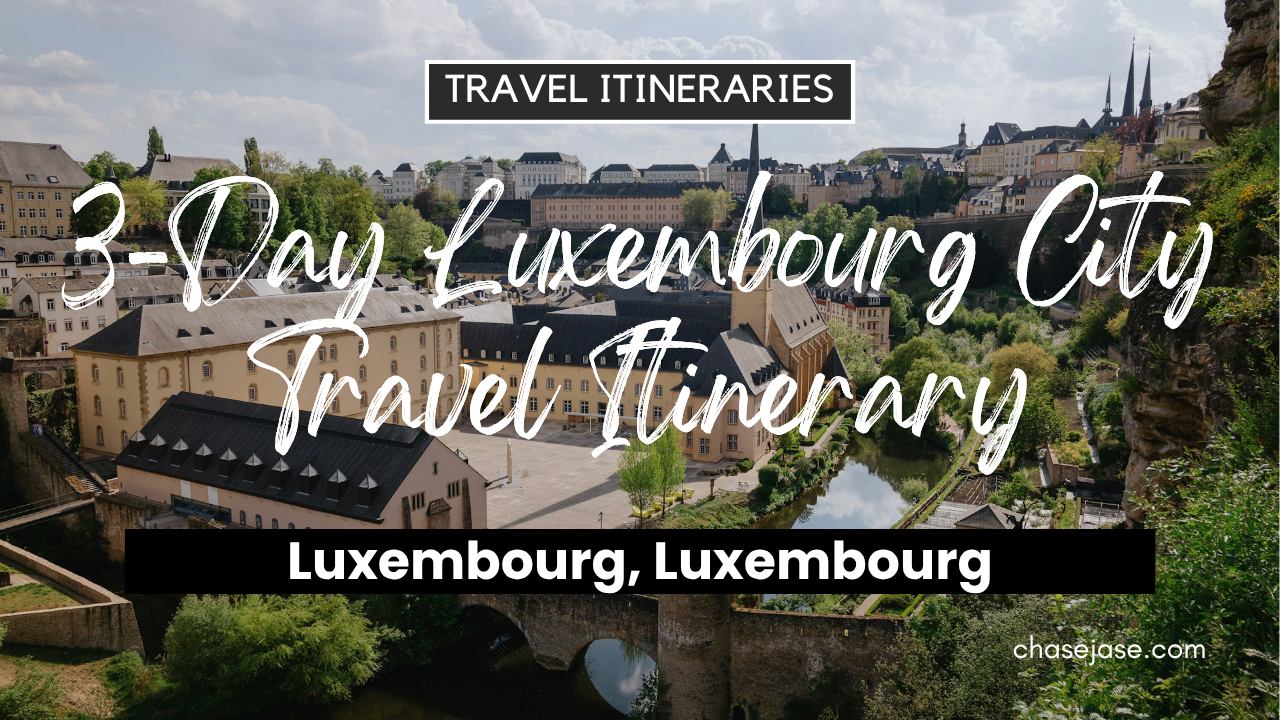3-Day Luxembourg City, Luxembourg Travel Itinerary

Introduction:
Luxembourg City is the capital of the Grand Duchy of Luxembourg, a compact yet culturally rich city located in the heart of Western Europe. Its geography is unique because the city is built on dramatic cliffs with deep gorges carved by the Alzette and Pétrusse rivers. Luxembourg City is known for its UNESCO-listed Old Town, fortress ruins, elegant bridges, and seamless blend of medieval charm and modern sophistication. As the seat of several European Union institutions, it is also an important center for finance and diplomacy. This 3-day itinerary in Luxembourg City is designed to help visitors experience the best historical, cultural, and scenic highlights while maximizing time and efficiency.
Places to Visit:
- The Bock Casemates (Casemates du Bock): This is a historic underground tunnel system built in the 17th century, offering a glimpse into the city’s fortified past.
- Palace of the Grand Duke: This official residence of the Grand Duke is a Renaissance-style palace in the city center, open for guided tours in summer.
- Notre-Dame Cathedral (Rue Notre Dame): This Gothic-style cathedral from the 17th century features stained glass windows, baroque interiors, and the royal crypt.
- Place Guillaume II (Knuedler): This is the main public square that hosts markets, events, and offers access to the city hall and restaurants.
- Chemin de la Corniche: Often called “Europe’s most beautiful balcony,” this promenade gives panoramic views over the old quarters and the valley below.
- Luxembourg City History Museum: This museum explores over 1,000 years of local history through interactive exhibits and archaeological finds.
- MUDAM – Museum of Modern Art: Located in the Kirchberg district, this museum features modern art in a building designed by I.M. Pei.
- Fort Thüngen: This 18th-century fortress, now partially restored, sits in the Dräi Eechelen Park and is linked to the city’s military history.
- Grund District: This riverside neighborhood is known for its picturesque medieval streets, quaint houses, and lively pubs.
- Pétrusse Valley Park: This lush park is nestled between cliffs and is perfect for walking, relaxing, or photographing the city’s bridges and landscapes.

Sample Itinerary:
Day 1: Historic Core and Scenic Views
- 9:00 AM – Begin at Notre-Dame Cathedral: Explore the Gothic architecture, royal crypt, and peaceful interior (45 minutes).
- 9:45 AM – Walk to Place Guillaume II (5-minute walk): Admire the equestrian statue of Grand Duke William II and visit the open-air market if available (30 minutes).
- 10:30 AM – Guided Tour of the Palace of the Grand Duke (2-minute walk): Discover the ceremonial halls and historical artifacts during the summer-only tour (1 hour).
- 12:00 PM – Lunch at Brasserie Guillaume on the square: Try local specialties such as Judd mat Gaardebounen (smoked pork with broad beans) (1 hour).
- 1:30 PM – Visit the Bock Casemates (10-minute walk): Explore tunnels, stone staircases, and cannon holes overlooking the Alzette (1 hour).
- 2:45 PM – Stroll along Chemin de la Corniche (10-minute walk): Take photos of panoramic city views and old fortress walls (45 minutes).
- 4:00 PM – Discover the Luxembourg City History Museum (5-minute walk): Learn about the city’s evolution through digital and historical displays (1.5 hours).
- 6:00 PM – Dinner at Restaurant Le Sud in the Grund district (10-minute taxi or 15-minute walk): Enjoy French cuisine by the river in a stylish setting (1.5 hours).
Day 2: Art, Culture, and Modern Districts
- 9:30 AM – Head to MUDAM (15-minute tram from city center to Kirchberg):
- Browse modern and contemporary artworks in an iconic structure (1.5 hours).
- 11:15 AM – Visit Fort Thüngen and the Dräi Eechelen Museum next door (5-minute walk):
- Tour restored fortifications and exhibitions about Luxembourg’s defense (1 hour).
- 12:30 PM – Lunch at the MUDAM Café or Restaurant Kennedy nearby: Enjoy modern European dishes with a view of the museum park (1 hour).
- 2:00 PM – Walk through the European District and see the European Court of Justice (10-minute walk): Learn about Luxembourg’s role in the EU (30 minutes).
- 3:00 PM – Return to the city center via tram (15 minutes): Stop by the Grand-Rue for shopping and snacks (1 hour).
- 4:30 PM – Relax at Pétrusse Valley Park (10-minute walk): Walk below the Adolphe Bridge and enjoy the green landscape (1 hour).
- 6:00 PM – Dinner at L’Osteria in Place d’Armes: Enjoy Italian fare in one of Luxembourg’s most lively dining squares (1.5 hours).

Day 3: Hidden Corners and Riverside Charm
- 10:00 AM – Explore the Grund District in depth: Visit the Neumünster Abbey, stroll along the Alzette River, and admire old bridges (1.5 hours).
- 11:45 AM – Coffee and pastry at Café de l’Académie nearby: Try local specialties like Gromperekichelcher (potato fritters) (45 minutes).
- 1:00 PM – Visit the National Museum of Natural History (5-minute walk): Discover Luxembourg’s biodiversity and geological history (1 hour).
- 2:15 PM – Ride the Pfaffenthal Panoramic Elevator: Enjoy a glass-sided lift offering sweeping views and a fun way to change elevation (30 minutes).
- 3:00 PM – Visit the City Skyliner observation tower (if available during summer events): Take 360° photos of the city’s skyline (30 minutes).
- 4:00 PM – Free time for last-minute shopping at Royal Hamilius Mall (15-minute walk): Explore luxury and local brands (1 hour).
- 5:30 PM – Final dinner at Um Plateau near the Alzette: Celebrate with creative European dishes and Luxembourgish wine (1.5 hours).
See Itinerary Map (Includes Places to Visit and Accommodations)
Best Time To Go:
The best time to visit Luxembourg City is during the spring and early summer months from May to July: this period has mild temperatures ranging from 15°C to 25°C, blooming gardens, and cultural events like Spring Processions and the Blues’n Jazz Rallye. September to October is also excellent for fall colors and wine festivals. Winter months from December to February are cold and quiet, but the city is beautifully lit during the Christmas Markets. July and August are warm but can be slightly more crowded due to school holidays.
Activities To Do:
- Take a guided walking tour of the Old Town: Local guides explain the rich layers of Luxembourg’s history while walking along scenic routes and hidden alleyways.
- Ride the Pfaffenthal Panoramic Elevator: This free glass elevator connects the upper and lower parts of the city and gives an exciting vertical view.
- Attend a classical concert at Philharmonie Luxembourg: This concert hall hosts world-class performances and is renowned for its modern acoustics.
- Try Luxembourgish cuisine at a local restaurant: Dishes like Bouneschlupp (green bean soup) and Riesling-pork chops offer a taste of local culinary culture.
- Cycle or walk the Alzette River trail: This flat riverside path is ideal for a relaxing stroll or bike ride through the lower city and past historic buildings.

Accommodations:
- Hotel Le Royal: A 5-star luxury hotel near the city center offering elegant rooms, fine dining, and a wellness center.

- Sofitel Luxembourg Europe: Located in Kirchberg, this upscale hotel is ideal for business or leisure with stylish design and gourmet restaurants.

- Hotel Parc Beaux-Arts: A boutique hotel in the Old Town housed in a restored 18th-century building with refined historical interiors.

- Hotel Simoncini: A modern art-inspired hotel located near Place d’Armes with contemporary design and breakfast included.

- Hotel Vauban: A well-rated hotel in a historic building on Place Guillaume II, offering convenience and traditional charm.

- Youth Hostel Luxembourg City: A clean and modern hostel in the Grund area with dorms, private rooms, and an on-site restaurant.

- Hotel Bristol: A budget-friendly option near the main train station offering basic rooms with good public transport access.

Transportation Options:
- Trams: The Luxembourg City tram system is modern, free, and ideal for travel between districts like the city center and Kirchberg.
- Buses: Public buses are extensive, frequent, and completely free throughout the entire country, including the capital.
- Walking: The compact size of the city makes it very walkable, especially around the Old Town and Grund district.
- Biking: Luxembourg City offers Vel’oh! public bikes, which can be rented at stations around the city for short rides.
- Taxis and Rideshare: Taxis are available but expensive; rideshare options like Uber are not yet available.
- Trains: The Luxembourg train station connects the city with other parts of the country and cross-border destinations like Trier or Brussels.
Tips:
- Take advantage of free public transport: Luxembourg offers nationwide free buses, trams, and trains, which is rare and budget-friendly.
- Wear comfortable shoes: Luxembourg City has cobblestone streets and steep slopes, so supportive footwear is essential.
- Use multilingual signage: Most locals speak Luxembourgish, French, German, and English, so asking for help is easy.
- Visit museums on free entry days: Many museums offer free entrance on the first Sunday of each month.
- Check opening hours in advance: Many attractions close on Mondays, so plan accordingly for museums and tours.
Luxembourg City is a small capital with a grand soul: it is packed with centuries of history, striking architecture, and panoramic landscapes. Over the course of three days, travelers can explore fortress ruins, walk UNESCO-listed streets, admire world-class art, and indulge in rich local cuisine. Its efficient public transport, walkability, and safety make it a stress-free European city break. Luxembourg’s unique mix of cultures and languages, along with its mix of old-world charm and modern flair, make it a truly rewarding destination. Whether you’re visiting for culture, history, or simply a peaceful escape, Luxembourg City delivers a full experience in just a few unforgettable days.



